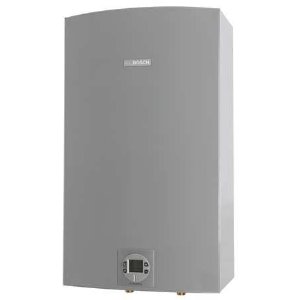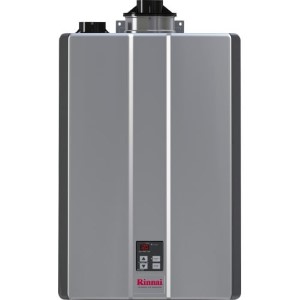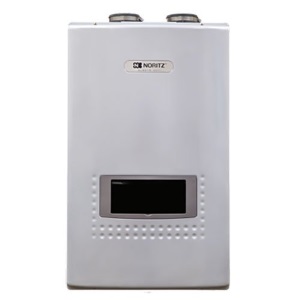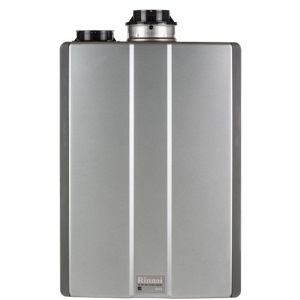- Home
- Rinnai water heaters
- Rinnai Boilers
Rinnai Boilers for Home and Water Heating: Advantages and Disadvantages
 Rinnai boiler
Rinnai boiler (photo: rinnai)
A review of Rinnai boilers utilizing condensing technology for combined whole-house space and water heating. Explore Rinnai condensing boilers features and advantages.
Rinnai condensing boilers are a cost-effective solution for homeowners who want to use only one heat source – gas, for both residential water and space heating. These gas boilers are designed small but powerful that can provide extra efficient heating and offer optimum comfort, economical, and convenient heating.
Rinnai boilers: Things to consider
Models review
Rinnai boilers are designed with condensing technology to provide high efficient space heating (CH) and domestic water heating (DHW) in different home sizes.
The manufacturer offers two lines of condensing gas boilers; heat only and combination, available in both Rinnai I-series and M-series.
The heat only group is for space heating only, while combination boilers allow homeowners to get hot water and home heating from the same unit.
The I-series is used in situations where multi-zone heating is needed. By using multiple thermostats, homeowners can set different temperatures throughout the home.
The M-series uses a built-in controller for easy temperature control and navigation.
Due to their intuitive design, Rinnai boilers offer flexible installation using concentric and twin pipe venting with long runs (up to 150 ft.), saving you money and time.
The smallest condensing boilers from Rinnai come with the max. gas input of 60,000 (CH)/103,000 (DHW) BTU, while the largest one offers the maximum power of 160,000 (CH)/199,000 (DHW) BTU. All models are ultra-efficiency models with a high EF factor of over 90%, which makes them Energy Star qualified and eligible for tax credits and rebates.
What is the difference between a combination and heat only boiler?
Rinnai combination boilers are a perfect solution for homeowners who would like to use one unit for space (central) and domestic water heating and at the same time. They use two heat exchangers to heat water on demand. Since they don't need a storage tank to store hot water, they take up much less space, making them a better option for smaller homes where storage space is limited.
Heat only boilers use a system with different valves, sensors, and pumps to heat water for use in a hydronic system. They can also be paired with a water storage tank to heat domestic water. Those hot water tanks can store a lot of water which is always ready for distribution. Since they need more space, heat only boilers are mostly used in larger homes, where greater quantities of hot water are needed instantly.
As said before, there are two series you can choose from; Rinnai M-series and I-series both made as heat-only and combination boilers.
Due to their greater heating capacity and maximum flow rate, Rinnai boilers from the I-series are designed for larger homes and families with higher hot water demand. The Rinnai M-series is ideal for families with smaller hot water needs, houses, and apartments.
| Combi boilers | Models | Gas input (BTU) (CH/DHW) |
Efficiency | Water flow (GPM) @70 F |
|---|---|---|---|---|
| M-series | M060CN | 60,000/103,000 | 95% | 2.6 |
| M090CN | 90,000/160,000 | 4.2 | ||
| M120CN | 120,000/160,000 | 4.2 | ||
| M160CN | 160,000/160,000 | 4.2 | ||
| I-series | i060CN | 60,000/160,000 | 95.1 | 4.1 |
| i090CN | 90,000/160,000 | 95.9 | 4.1 | |
| i120CN | 120,000/199,000 | 95.5 | 5.1 |
| Heat only boilers | Models | Gas input (BTU) |
Efficiency |
|---|---|---|---|
| M-series | M060SN | 60,000 | 95% |
| M090SN | 90,0000 | ||
| M120SN | 120,000 | ||
| M160SN | 160,000 | ||
| I-series | i060SN | 60,000 | 95.1 |
| i090SN | 90,000 | 95.9 | |
| i120SN | 120,000 | 95.5 | |
| i150SN | 150,000 | 96 |
Advantages
- All Rinnai boilers are high efficient, with an efficiency of around 95%, making them Energy Star qualified, which ensures significant savings.
- Combination boilers can deliver hot water and home heating simultaneously.
- Multi-zone heating is available for independent temperature control.
- Each model can adjust its power to optimize performance and maximize savings.
- Compact size provides space-saving installation.
- Ideal for new homes while they can be simply retrofitted to replace the old tank-type models.
- As tankless water heaters, Rinnai boilers are also wall-mounted.
- All Rinnai condensing boilers are equipped with a durable and reliable stainless steel condensing heat exchanger.
- All the boilers are designed to work on both natural gas and propane gas, where the conversion kit is used to convert one fuel type to another.
- A variety of venting options is available for flexible installation. Every Rinnai condensing boiler can use PP, stainless steel, PVC, and CPVC venting.
- Direct vent sealed combustion makes the room and closet installation possible.
- Rinnai gas condensing boilers are ASME (American Society of Mechanical Engineers) certified to meet relevant safety specifications.
- Boilers are equipped with outdoor sensors making them weather-dependent.
- Rinnai boilers are equipped with electronic spark ignition, which automatically lights the burner (no pilot light).
- At the front of the unit, there is a control panel which is consisted of the display and function buttons. The display shows the boiler status, error, and maintenance messages, while the buttons have control over the pump, central heating, domestic hot water heating, and service modes.
- Ultra quiet: sound level is up to 54 dB
- Ultra-low NOx gas emission makes them eco-friendly.
- Long 12-year warranty.
Disadvantages
- The main disadvantage is that Rinnai boilers are expensive.
Summary
Rinnai boilers are expensive, but they offer premium quality of its components and ultra-efficient condensing technology, so the heating of your home and domestic water is economical and reliable. These superb devices are packed in a small and compact tankless design that doesn't occupy valuable living space - they are wall-mounted that can be installed almost anywhere.
- Home
- Rinnai water heaters
- Rinnai Boilers












